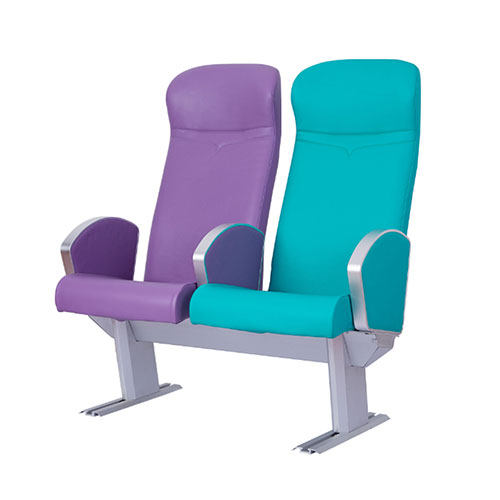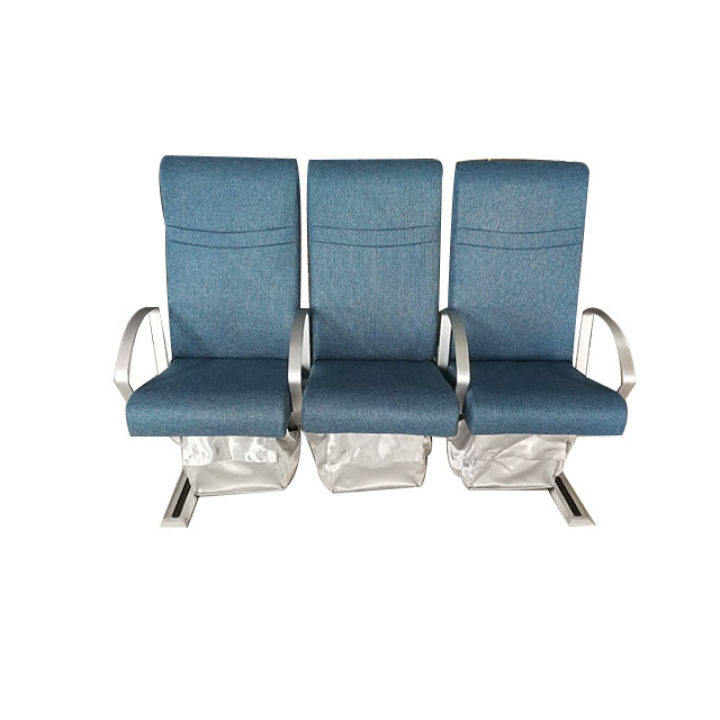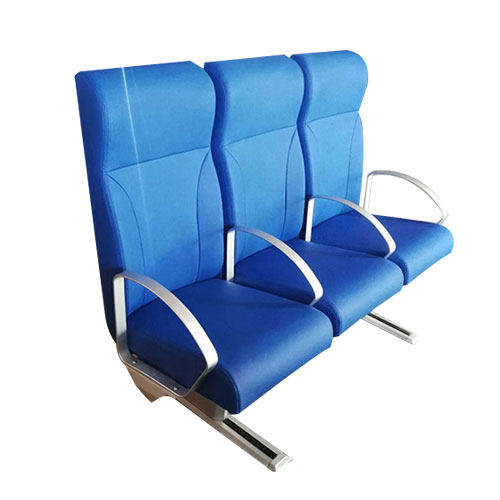What are Important Considerations for Designing Marine Passenger Seats
Marine passenger seats are critical in ensuring a comfortable and secure travel experience for everyone on board. These chairs are specifically built to endure the unique difficulties of the marine environment while providing ideal comfort and utility on everything from cruise ships and ferries to offshore vessels and yachts.

Design Considerations for Marine Passenger Seats
Ergonomics: Design seats that offer maximum comfort and support to customers during sea travel. To fit diverse body types and promote appropriate posture, consider seat height, width, depth, and backrest angle.
Seating Configuration: Determine the best seating arrangement depending on the vessel’s layout and passenger capacity. Consider aisle width, legroom, and accessibility for guests with mobility issues.
Seat Cushioning and Padding: High-quality cushioning materials that provide enough support and pressure distribution should be used. Because marine seats may be prone to vibrations and impacts, choose materials that can endure such conditions while yet providing passenger comfort.
Upholstery and Coverings: Choose upholstery materials that are long-lasting, water-resistant, and easy to clean in marine situations. Consider materials that are resistant to fading, mildew, and saltwater damage. Additionally, make certain that the coverings adhere to fire safety laws.
Safety Features: Include safety equipment such as seat belts or harnesses to keep passengers safe during stormy seas or unexpected vessel movements. Ascertain that the safety devices are simple to use and adhere to appropriate safety regulations.
Structural Strength and Stability: Design seats with durable frames and design to endure the stresses encountered during maritime travel. Consider the materials used to ensure long-term durability, such as corrosion-resistant metals or high-strength composites.
Vibration and Shock Absorption: Implement devices or materials that decrease the passage of vibrations and shocks to the passenger seats, which can improve passenger comfort and reduce the danger of weariness or discomfort during long-distance travel.
Aesthetics and Branding: Create a visually appealing design that complements the overall interior aesthetics and branding of the vessel. Color schemes, patterns, and finishes that enhance the passenger experience and represent the maritime ambiance should be used.
Maintenance and Cleanliness: Because coastal surroundings are prone to filth, salt, and moisture, design chairs that are simple to maintain and clean. Consider replaceable and washable seat covers, as well as components that are easily accessible for routine maintenance and repairs.
Regulatory Compliance: Ensure that the passenger seats are designed and constructed in accordance with appropriate maritime safety and regulatory standards, including requirements for stability, fire safety, and evacuation protocols.

Ergonomics and Comfort of Marine Passenger Seats
Ergonomics and Comfort of Marine Passenger Seats
The ergonomics and comfort of marine passenger chairs are critical in improving overall travel experience and assuring passenger satisfaction. Here are some key considerations to prioritize when designing marine passenger seats:
Seat Contouring: Design contoured seats that fit to the natural curves of the human body, giving optimal support and encouraging appropriate posture. To distribute pressure evenly and decrease discomfort during lengthy periods of sitting, consider the curves of the seat bottom, backrest, and headrest.
Seat Padding and Cushioning: Make use of high-quality padding materials that provide enough cushioning and shock absorption. The cushioning should give a balance of comfort and support, easing pressure areas while remaining stable. Consider incorporating foam or gel inserts to enhance comfort levels.
Lumbar Support: Adjustable lumbar support should be included in the design to suit passengers with various needs. Lumbar support promotes proper sitting posture by preserving the natural curve of the spine.
Seat Width and Depth: Allow enough seat width and depth to properly accommodate people of all sizes. Seats that are too narrow or shallow might cause discomfort and restricted movement.
Armrests: Include armrests that are properly positioned and padded to support the passenger’s arms and provide a place to rest. Armrests should be at a comfortable height for passengers to maintain a relaxed posture without raising their shoulders. Consider the optimum seat height to allow passenger ease of entry and exit.
Seat Height: Consider the optimum seat height to allow passenger ease of entry and exit. Seats should be appropriate with the deck height of the vessel and allow passengers to plant their feet firmly on the floor for stability.
Seat Upholstery: Choose upholstery fabrics that are not only comfy but also water, mildew, and stain resistant. Seats in marine locations are susceptible to water splashes, salt, and other impurities, so choosing long-lasting, water-resistant textiles or marine-grade vinyl is critical.
Ventilation: Include ventilation features in the seat design to improve airflow and avoid heat buildup, which is especially important in hotter areas. Proper ventilation can aid in the reduction of perspiration and the enhancement of passenger comfort.
Noise and Vibration Dampening: Implement measures to reduce the transfer of noise and vibration to the seats. To alleviate discomfort caused by vibrations and engine noise, this can involve employing vibration-absorbing materials or isolating the seat mounting from the vessel’s structure.
Accessibility: Ensure that seats are built to accommodate passengers with mobility issues, such as those using wheelchairs or walkers. Consider broader seat dimensions, retractable armrests, and unobstructed routes throughout the seating area for simple movement.

Safety Standards and Compliance of Marine Passenger Seats
Regulatory Requirements: Familiarize yourself with the applicable norms and standards for marine passenger seating. These may include recommendations from organizations such as the International Maritime Organization (IMO), the United States Coast Guard (USCG), and classification societies such as Det Norske Veritas Germanischer Lloyd (DNV GL) or Lloyd’s Register (LR). Keep up to date on any updates or amendments to these regulations.
Seat Strength and Durability: Marine passenger seats must be structurally solid and able to endure the dynamic stresses experienced during vessel operations. Consider seat frame materials, reinforcements, and load testing to guarantee proper strength and durability.
Fire Safety: Marine seating materials must meet fire safety norms, such as the International Convention for the Safety of Life at Sea (SOLAS) requirements for fire resistance. Use fire-retardant materials and ensure compliance with relevant flammability standards, such as the International Maritime Organization’s Fire Test Procedures Code (FTP Code).
Seat Belt Systems: Install proper seat belt systems to improve passenger safety and reduce the danger of harm in turbulence or crashes. Follow seat belt design industry standards, including buckle types, webbing strength, and connection places. Consider utilizing a three-point or lap-and-shoulder seat belt.
Impact Resistance: Seats should be designed with impact-resistant characteristics to reduce the impacts of crashes or mishaps. Seat constructions and attachment points should be reinforced to withstand impact forces and limit the danger of seat detachment or failure.
Slip Resistance: Slip-resistant materials or surface treatments should be used on seat surfaces and around the seats to protect passengers from slipping or falling, especially when the vessel is in motion or in wet weather.
Accessibility: Ensure that maritime passenger seats meet accessibility criteria in order to accommodate people with disabilities. Consider factors such as seat height, armrest design, and maneuvering space to facilitate ease of use for passengers with mobility challenges.
Documentation and Certification: Keep detailed records of seat design, materials, manufacturing procedures, and compliance testing. To demonstrate conformity with safety standards, obtain required certificates or approvals from recognized authorities or classification organizations.
Crash Testing: Consider conducting crash tests or simulations to evaluate the performance of the seat during impact scenarios. This can assist in identifying areas for improvement as well as validating compliance with safety regulations.
Ongoing Compliance Monitoring: Review and evaluate seat designs and materials on a regular basis to guarantee continuous compliance with changing safety requirements and standards. Keep up to speed on industry developments, safety bulletins, and best practices to ensure the safety of maritime passenger seats.
Summary
Marine passenger seats are not only necessary for safety, but they also contribute to the whole passenger experience on the high seas. These marine chairs are designed to assure comfort, durability, compliance with safety regulations, and accessibility for all passengers, from opulent cruise liners to efficient ferry services.


